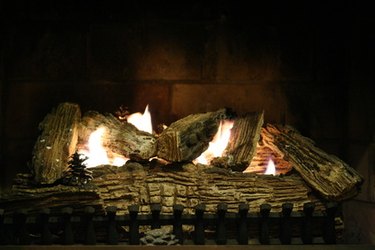Things You'll Need
New Refractory Brick Fireplace Panels
Screwdriver

Most everyone who has a fireplace in their home has at some point come to notice that the back and side walls of the fireplace have begun to decay, necessitating repair. To fix such a problem most often requires that the refractory brick fireplace panels be replaced. While many people might see this as a job for a professional, it is eminently doable by the average homeowner, and doing so will save a lot of money.
Step 1
Spread out a tarp in front of your fireplace. Installing refractory panels is dirty work; before you do anything else, lay down a tarp from the edges of the fireplace out into the room. Refractory panels are sheets made of ceramic brick that line the sides and back of your fireplace. They serve two purposes. The first is to keep the walls next to the fireplace from becoming too hot, thus preventing a fire where it's not supposed to be. The other purpose is to cause the heat that is created by the fire to be sent back out into the room rather than up the chimney. They are held in place with screws and clamps. Refractory panels connect to the firebox, which is, in essence, an iron frame with a cement floor. The firebox sits between two walls on either side and the back wall, usually made of brick. Virtually all fireplaces that are constructed out of fireboxes have three refractory brick fireplace panels; one in the back and one on each side of the fireplace.
Video of the Day
Step 2
Remove the grill and clean out the fireplace. Pull the grill out of the fireplace and take it outside for cleaning. Scrub it with a wire brush, hose it off and let it dry while you're installing the refractory panels. Scrape out as much of the ash from the fireplace as possible, then scrub the floor of the fireplace with dish soap and water. Doing so will help reduce the mess in the long run.
Step 3
Locate the panel clamps, which are long, thin flat pieces of metal that run the length of each panel along the front perimeter of the fireplace. There are three of them; one runs along the top front of the fireplace and the other two are on either side of the fireplace. Their purpose is to hold the panels in place. Each clamp has between four and six screws.
Step 4
Remove the clamp and panel. To remove the panels, unscrew the screws that hold the clamps in place with a screwdriver. Once the screws are out, the clamp will fall free into your hands. Remove all three clamps. Then reach in and pull out the panels, starting with the one on the right wall.
Step 5
Clean the area again. Once again sweep up any ash or bits of charcoal that might have become dislodged and fallen into the fireplace. Examine the firebox; with the panels removed, it will be easy to see if there is any structural damage to your firebox or heat damage to the surrounding walls. If so, you will have to replace the entire firebox.
Step 6
Compare the old panels with the new. It is very important that the new panels are the same size as the old ones. If they are not, a fire hazard can be created. Lay the new panels on top of the old ones to make sure they are the same size. If not, return them and get the right ones.
Step 7
Push the news panels into place. Start with the back panel. Place it into position where the old one was. Once it is in, push the side panels into place.
Step 8
Put the clamps on and screw them into place. Hold the clamps in place while you screw the screws back into the clamps.
Tip
Refractory panels are heavy, so if you lack upper-body strength, you might want to get someone to assist you in pulling out the old ones and installing the new.
Warning
Only use panels that are recommended by the manufacturer of your fireplace. Using panels that are not recommended by the manufacturer presents a fire hazard. Be sure there is at least 2 inches of clearance between the back of the firebox components and any combustible materials, such as wood or drywall. Most firebox manufacturers recommend that refractory panels be replaced by a professional.
Video of the Day